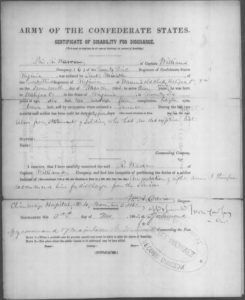A 26 year old paper-maker from Dedham, MA, Clinton Bagley was a Private in Company I, 35th Massachusetts Infantry when he was wounded at Fox’s Gap on South Mountain on 14 September 1862. He was Sergeant Major of his regiment by the end of his service in June 1865, as seen in this fine photograph provided by his great-great-granddaughter Jane Christopher.
Bagley fought in just about all of the battles of his regiment through the war, as listed in his record in the Descriptive Book for Company I of the 35th Massachusetts. Here’s the War Department transcription of that record on a card (front and back) now in the US National Archives, hosted online by fold3:
Ransom Warren (1862)
25 July 2022
Here are a pair of interesting documents from Ransom Warren‘s Compiled Service Records at the US National Archives. I got my copies online from fold3.
The first is the parole he signed with his mark in Sharpsburg after his wounding there on 17 September 1862 and subsequent capture by Federal troops. He was a Private in Company E of the 23rd Virginia Infantry.
And this is his Confederate certificate of disability which followed from the loss of his right arm to amputation.
Lt. T.S. Michaels, Goochland Grays (1862)
25 July 2022
2nd Lieutenant Thomas Scott Michaels was detailed to recruit for his Company in the 23rd Virginia Infantry in February and March 1862. Here’s his announcement, clipped from the Richmond Dispatch of 7 March 1862. I found it online thanks to the Library of Virginia.






